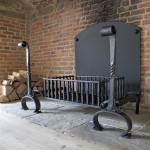Good Colors to Paint a Fireplace: A Comprehensive Guide
A fireplace serves as a focal point in many homes, often acting as a gathering place and a significant design element. The color of the fireplace, therefore, plays a critical role in shaping the overall aesthetic of the room. Selecting the appropriate paint color requires careful consideration of factors such as the existing decor, the desired mood, and the fireplace material itself. This article will explore a range of color options suitable for painting a fireplace, examining their suitability based on various design principles and practical considerations.
Before delving into specific color recommendations, it is important to understand the preliminary steps involved in painting a fireplace. Thorough cleaning is essential to remove soot, dust, and any existing loose paint. Depending on the material, a suitable primer should be applied to ensure proper adhesion and prevent the paint from being absorbed unevenly. For brick fireplaces, a masonry primer is generally recommended. For wood mantels, a wood primer is necessary. Choosing a paint formulated for high-heat environments is also crucial, especially for the firebox area. Latex paints are often preferred for their durability and ease of cleaning.
Understanding the Impact of Color Psychology
Color psychology studies the effects of colors on human behavior and perception. Understanding these effects can be invaluable when selecting a fireplace color. Different colors evoke different emotions and associations. For example, warm colors like red, orange, and yellow tend to create a sense of energy and excitement, while cool colors like blue, green, and purple promote calmness and relaxation. Neutral colors, such as white, gray, and beige, offer a sense of balance and sophistication. The choice of color should align with the desired atmosphere within the room.
Consider the existing color palette of the room. The fireplace color should complement the wall colors, furniture, and accessories. A harmonious color scheme creates a cohesive and visually appealing space. If the room features bold, vibrant colors, a neutral fireplace may provide a grounding element. Conversely, in a room with neutral walls, a more colorful fireplace can serve as a statement piece.
The amount of natural light in the room also influences color perception. Darker colors tend to absorb light, making a room feel smaller and more intimate. Lighter colors reflect light, creating a more open and airy atmosphere. If the room receives limited natural light, opting for a lighter fireplace color can help to brighten the space.
Exploring Neutral Color Options
Neutral colors are versatile and timeless choices for painting a fireplace. They offer a blank canvas that can be easily adapted to changing decor styles. White, in particular, is a popular option due to its clean, crisp appearance. A white fireplace can brighten a room and create a sense of spaciousness. However, it is important to select the right shade of white. A stark white can sometimes feel cold and sterile, while a warmer white with subtle undertones of cream or beige can create a more inviting atmosphere.
Gray is another sophisticated neutral option. It offers a more modern and contemporary look than white. Gray comes in a wide range of shades, from light and airy to deep and dramatic. A light gray fireplace can provide a subtle contrast against white walls, while a darker gray can create a bold statement. Consider the undertones of the gray, as some grays have cool blue undertones, while others have warmer brown undertones. The undertone should complement the other colors in the room.
Beige and other warm neutrals like greige (a blend of gray and beige) offer a cozy and inviting feel. These colors can soften the hard lines of a fireplace and create a more comfortable atmosphere. They work well in rooms with natural wood tones or other warm colors. Beige can also be a good choice for hiding soot stains, although regular cleaning is still recommended.
When using neutral colors, consider adding texture to the fireplace. This can be achieved through the use of different painting techniques, such as stippling or ragging. Alternatively, adding decorative elements like stone veneer or reclaimed wood can enhance the visual interest of the fireplace.
Bold and Statement Colors for Fireplaces
While neutral colors offer versatility and timelessness, bold and statement colors can inject personality and drama into a room. However, choosing the right bold color requires careful consideration and a clear vision for the overall design. It is crucial to avoid selecting a color simply because it is trendy; instead, focus on colors that resonate with personal style and complement the existing decor.
Black is a classic and sophisticated choice for a fireplace. It can create a dramatic contrast against light walls and add a sense of elegance to the room. A black fireplace can also ground a space and provide a focal point. However, black can also make a room feel smaller and more enclosed, so it is best used in rooms with ample natural light. Consider using a matte black finish to avoid excessive glare.
Deep blues and greens can create a calming and sophisticated atmosphere. These colors evoke a sense of nature and can be particularly effective in rooms with a coastal or bohemian aesthetic. Navy blue is a popular choice for its timeless appeal, while emerald green can add a touch of luxury. When using dark colors, ensure that the room is well-lit to prevent it from feeling too dark or gloomy.
Red, orange, and yellow are warm and energetic colors that can create a sense of excitement and warmth. However, these colors should be used sparingly, as they can be overpowering. A brick red fireplace can add a rustic charm to a room, while a vibrant yellow can create a cheerful and inviting atmosphere. Consider using these colors as accents rather than painting the entire fireplace, as they can be visually stimulating.
When using bold colors, it is important to balance them with neutral elements. For example, a black fireplace can be paired with white walls and light-colored furniture. A brightly colored fireplace can be balanced with neutral accessories and artwork. This will prevent the room from feeling overwhelming or chaotic.
Before committing to a bold color, test it out with paint samples. Paint a small area of the fireplace and observe how the color looks in different lighting conditions. This will help to ensure that the chosen color is the right fit for the room.
Considerations for Fireplace Material
The material of the fireplace significantly influences the final appearance of the painted color. Brick, stone, wood, and metal each require different preparation techniques and may react to paint differently. Understanding the specific characteristics of the fireplace material is essential for achieving a professional and long-lasting finish.
Brick fireplaces are porous and can absorb a significant amount of paint. To prevent the paint from being absorbed unevenly, a masonry primer is necessary. This primer seals the brick and provides a smooth surface for the paint to adhere to. When painting brick, consider using a textured paint or a faux finish to enhance the natural texture of the brick. Also, be mindful of the mortar joints between the bricks. These can be painted the same color as the brick or a contrasting color to create visual interest.
Stone fireplaces can be more challenging to paint due to their irregular surfaces. However, painting a stone fireplace can dramatically transform its appearance. As with brick, a masonry primer is essential. When painting stone, consider using a paint brush to get into the crevices and ensure even coverage. Alternatively, a paint sprayer can be used to apply the paint more evenly. Consider leaving some of the stone unpainted to highlight its natural beauty.
Wood mantels can be painted with a variety of colors to complement the surrounding decor. A wood primer is necessary to prevent the paint from peeling or chipping. When painting wood, smooth sanding before priming is crucial to ensure a smooth finish. Consider using a gloss or semi-gloss paint for wood mantels, as these finishes are more durable and easier to clean.
Metal fireplaces, particularly those made of cast iron, can be painted with heat-resistant paints. These paints are formulated to withstand high temperatures and prevent the paint from blistering or cracking. When painting metal, ensure that the surface is clean and free of rust. A metal primer is necessary to prevent corrosion. Black is a popular choice for metal fireplaces, but other colors can also be used to create a unique look.
In addition to the material, consider the style of the fireplace. A traditional fireplace may look best with classic colors and finishes, while a modern fireplace may benefit from more contemporary colors and techniques. Adapting the paint color and technique to the specific style of the fireplace will enhance its overall aesthetic appeal.

Pin On Home Sweet

The Top Color Ideas For Painting A Brick Fireplace 700 N Cottage

Best Paint Colors For A Painted Fireplace Macfarland Painting

Paint Color Picks For Magnificent Mantels Tinted Sherwin Williams

Our Black Painted Fireplace Bright Green Door

30 Gorgeous Painted Brick Fireplace Ideas
:max_bytes(150000):strip_icc()/195949384_533489974504579_3035995865627682669_n-3c30dc0791c74ced9847f823ec3a55d1.jpg?strip=all)
30 Gorgeous Painted Fireplace Ideas

ᑕ❶ᑐ How To Paint Your Brick Fireplace For Home

Guide To Fireplace Painting Part 2 Colors And Techniques

7 Beautiful Ideas For Painting Interior Brick Fireplaces








